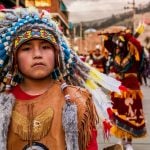The Southwest Culture Area
In providing a broad overview of the hundreds of distinct American Indian cultures found in North America, it is common for museums, historians, archaeologists, and ethnologists to use a culture area model. This model is based on the observation that different groups of people living in the same geographic area often share many cultural features.
 The map shown above shows the primary North American Indian culture areas.
The map shown above shows the primary North American Indian culture areas.
The Southwest Culture Area is a culturally diverse area. Geographically it covers all of Arizona and New Mexico and includes parts of Colorado, Nevada, Utah, and Texas as well as parts of the Mexican states of Sonora and Chihuahua. Much of this area is semi-arid; part of it is true desert (southern Arizona); and part of it has upland and mountain ranges which support conifers.
The Southwest, despite being an arid, inhospitable land, was the first area in the United States to develop agriculture. Anthropologist Alice Beck Kehoe, in her book America Before the European Invasions, writes:
“From the standpoint of economics, Southwesterners should have always made their living by seasonal movements of small bands harvesting relatively sparse but varied wild foods; contrary to common sense, for three thousand years most Southwesterners have farmed, investing much labor in nurturing maize on land alien to it.”
Looking at the Southwestern tribes culturally, it is common to identify four distinct traditions: Pueblo, Athabascan, Piman, and Yuman.
In northern Arizona and New Mexico there are several Indian tribes who have traditionally lived in compact villages. The Spanish used the word pueblo which means “town” in referring to these people. The Pueblo people are not a single cultural tradition but are in fact several distinct cultures. They share some features – farming, housing – and are very different in others.
Around 1400 CE a new group of people began to enter the Southwest. These Athabascan-speaking people – the Navajo and the Apache – migrated from the area north of Edmonton, Alberta.
The Sonoran desert of Arizona and Sonora is the home of a number of Piman-speaking groups, primarily the Tohono O’odham (Papago) and Akimel O’odham (Pima).
The area along the Colorado and Gila Rivers was the traditional home to a number of Yuman-speaking tribes.
 The shaded area on the map shown above shows the Southwest culture area.
The shaded area on the map shown above shows the Southwest culture area.
In contrasting the Southwestern culture area from the adjacent Great Basin, California, and Plains culture areas, John Ware, in his overview of the Southwest in I Am Here: Two Thousand Years of Southwest Indian Arts and Culture, writes:
“The Southwest was distinguished from these adjacent culture areas by an early commitment to farming—in some cases as a minor supplement to wild foods, in other cases as a major investment in agriculture and all its technical and organizational ramifications.”
The Maryhill Museum of Art near Goldendale, Washington, has a good collection of Southwestern Indian artifacts. According to the display:
“Southwestern art was stylistically varied, as might be expected from the diverse cultures found there. Basketry was important for all tribes except the Navajo, who excelled at rug weaving after the Spanish introduction of sheep. Pottery was highly developed only among the Pueblos. Woodcarving, leatherwork, sand painting, and jewelry making were also important in this area.”
O’odham Baskets
According to the Museum display:
“Akimel O’odham (Pima) and Tohono O’odham (Papago) baskets are very similar. Akimel O’odham weaving was historically the finer and more intricate of the two. Tohono O’odham baskets have large, somewhat flattened coils and bolder, less detailed designs. Geometric patterns—particularly arrangements of concentric lines—frequently appear. Representations of human beings, deer and other animals are also common. Bowls and trays were historic forms but other shapes were created for sale to outsiders.”
Jicarilla Apache Baskets
The baskets shown below were made for sale to non-Indians. The elaborate looped rim and ring handles are an indication that the basket was made for the tourist trade.
Mescalero Apache Baskets
According to the Museum display:
“Among the Mescalero Apaches, coiled baskets were usually made with a two-rod or a bundle of sumac, sewn with split yucca. The white background was made from bleached yucca, while the green or yellow elements were made from unbleached portions of the plant. Red-brown accents utilized yucca roots. Geometric patterns and star shapes are common design elements.”
Western Apache Baskets
 The small burden basket on the left was made about 1900 and the one in the center was made in the late 1980s by Novena Cobb (San Carlos Apache).
The small burden basket on the left was made about 1900 and the one in the center was made in the late 1980s by Novena Cobb (San Carlos Apache).
Pueblo Pottery
Pueblo pottery is one of the best known American Indian art forms. For many centuries, Pueblo people have made and used a wide variety of pottery containers, including bowls, jars, cups, ladles, and canteens. In addition, Pueblo potters also produced figurines, effigy vessels to be used for religious purposes, pipes, and prayer meal bowls. The pottery is often highly decorated and traded throughout the region.
Pottery varies among the Pueblos according to differences in raw materials, technology, and aesthetics. Each of the Pueblos has its own distinctive decorative styles. In addition, within a Pueblo the work of a particular potter, or the potter’s family, can sometimes be recognized.
Pueblo pottery since the later 1800s has become renowned as collectable art work and this has created some conflicts with traditional Pueblo culture. The collectors who buy Pueblo pottery, almost all of whom are non-Hopi, want to know who made the piece and therefore a signature on the pot is important to them. In an article in American Indian Art, Dwight Lanmon and Francis Harlow note:
“Traditional Pueblo culture views the individual as a vital part of the whole, and personal recognition has largely been shunned. This attitude changed slowly in the 1900s and recognition of the work of individual potters has now become commonplace.”
 Shown above from left to right are pots by: (left) Adelle Lalo Nampeyo (Hopi); (center) Caroline Loretto (Jemez), and (right) Stephanie Naranjo (Santa Clara).
Shown above from left to right are pots by: (left) Adelle Lalo Nampeyo (Hopi); (center) Caroline Loretto (Jemez), and (right) Stephanie Naranjo (Santa Clara).  Shown above is an Acoma polychrome olla with parrot motifs made about 2014 by Beverly “B.D.” Garcia.
Shown above is an Acoma polychrome olla with parrot motifs made about 2014 by Beverly “B.D.” Garcia.  Shown above are blackware San Ildefonso jars made in the 1940s and 1950s by María Martinez (1887-1980) and Santana Roybal Martinez (1909-2002) (jar on left) and María Martinez and Popovi Da (1923-1971) (jar on right).
Shown above are blackware San Ildefonso jars made in the 1940s and 1950s by María Martinez (1887-1980) and Santana Roybal Martinez (1909-2002) (jar on left) and María Martinez and Popovi Da (1923-1971) (jar on right).  Shown above is a Cochiti storyteller figure made in 1979 by Helen Cordero (1915-1994).
Shown above is a Cochiti storyteller figure made in 1979 by Helen Cordero (1915-1994).  Shown above is an incised Santa Clara blackware jar made in the 1980s by Stella Chavarria.
Shown above is an incised Santa Clara blackware jar made in the 1980s by Stella Chavarria.  Shown above is a Zia lidded jar made about 2015 by Elizabeth Medina.
Shown above is a Zia lidded jar made about 2015 by Elizabeth Medina.  The pottery shown above was made by unknown Zuni artists between 1880 and 1920.
The pottery shown above was made by unknown Zuni artists between 1880 and 1920.
Jewelry
The Southwestern tribes are well-known for their jewelry. In her essay on jewelry in Dimensions of Native America: The Contact Zone, Caroline Klarr writes:
“For thousands of years native peoples of the southwestern United States have produced items for personal adornment made from shell, turquoise, and other semi-precious stones, mined locally or obtained through trade.”
 Shown above are Zuni-style fetish necklaces made about 2010 by unknown artists (Zuni or Navajo).
Shown above are Zuni-style fetish necklaces made about 2010 by unknown artists (Zuni or Navajo).
Beadwork
 Shown above is a beaded pendant made in 2016 by Valerie Willie (Navajo).
Shown above is a beaded pendant made in 2016 by Valerie Willie (Navajo).











